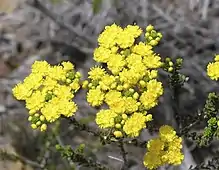| Verticordia sect. Sigalantha | |
|---|---|
 | |
| Scientific classification | |
| Kingdom: | Plantae |
| Clade: | Tracheophytes |
| Clade: | Angiosperms |
| Clade: | Eudicots |
| Clade: | Rosids |
| Order: | Myrtales |
| Family: | Myrtaceae |
| Genus: | Verticordia |
| Subgenus: | Verticordia subg. Chrysoma |
| Section: | Verticordia sect. Sigalantha |
| Type species | |
| Verticordia serrata | |
| Species | |
|
2 species: see text. | |
Verticordia sect. Sigalantha is one of seven sections in the subgenus Chrysoma. It includes two species of plants in the genus Verticordia. Plants in this section are rigid shrubs with a single main stem and are up to 1.0 m (3 ft) tall. They have golden-yellow flowers with prominent shining petals. The flowers are arranged in corymb-like groups and become pale or grey as they age. The bracteoles fall off the flower as it opens.[1] When Alex George reviewed the genus in 1991, he described the section and gave it the name Sigalantha.[2][3] The name Sigalantha is derived from the Ancient Greek words sigaloeis meaning "shiny"[4]: 481 and anthos meaning "flower"[4]: 338 referring to the shiny petals of these species.
The type species for this section is Verticordia serrata and the other species is V. integra.[1]
References
- 1 2 (Berndt) George, Elizabeth A.; Pieroni, Margaret (2002). Verticordia : the turner of hearts. Crawley, Western Australia ;Canberra: University Of Western Australia Press. p. 103. ISBN 1876268468.
- ↑ "Verticordia sect. Sigalantha A.S.George". APNI. Retrieved 22 September 2016.
- ↑ George, Alex (1991). "New taxa, combinations and typifications in Verticordia (Myrtaceae : Chamelaucieae)". Nuytsia. 7 (3): 270.
- 1 2 Brown, Roland Wilbur (1956). The Composition of Scientific Words. Washington, D.C.: Smithsonian Institution Press.